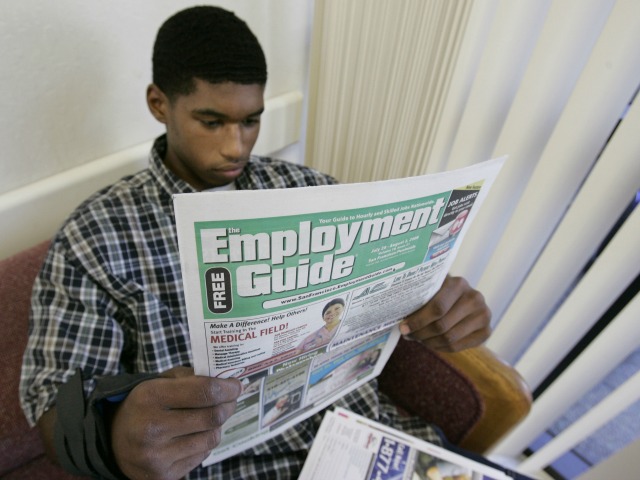While the White House and many like-minded media commentators are touting that the unemployment drop from 6.7 to 6.3 percent is good news, the reality is other economic indicators reveal the 6.3 number is terrible for the long-term health of the U.S. economy. The number that matters most–the labor participation rate–has dropped to a shocking low of 62.8 percent.
The unemployment number is used because it’s a simple statistic that’s easy to repeat on television, but it’s relatively useless as an indicator of the national job market. It counts as “employed” those who are underemployed with, for example, a part-time job that pays $18,000 a year, when that worker is seeking a full-time job paying $45,000 to be economically secure.
But more fundamentally, it measures the percentage of people who are actively looking for a job at the moment, yet cannot find one. It does not factor in those who are capable of working, but are not trying to work.
The relevant number–and one that commentators need to focus on until it becomes the baseline figure for discussion with the American people–is the labor participation rate (also called the labor force participation rate or the workforce participation rate). The short description of this metric is the percentage of Americans who are able to work who have a job or are actively trying to secure a job. (It still counts the underemployed, but it’s more useful than the unemployment rate.)
There were encouraging aspects about the May 2 report on the labor market. Employers added an estimated 288,000 jobs in April, on top of 203,000 added in March. Today’s numbers beat the forecast of 218,000. Hiring is accelerating, at least in the short-term. (Note, also, that these numbers are just tentative and will be revised in a few weeks.)
But the number that puts a heavy damper on the whole economic outlook (without even discussing taxes, spending, or deficits) is that 800,000 Americans dropped out of the labor force altogether last month. Almost 1 million Americans who are able-bodied and willing to work–and who previously had been looking for a job–have now given up, and are living off others or off the taxpayers through government welfare.
For example, some media outlets are crowing that the 6.3 percent unemployment is the lowest since September 2008, before the collapse of Lehman Brothers. But the labor participation rate in that month was 66.0 percent, far higher than today.
Today, with the same 6.3 percent unemployment, millions more Americans are without a job. The last time the labor rate was this low was 36 years ago, in 1978. Currently, there are almost 100 million adult Americans without a job.
One of the essential pillars of America’s long-term economic superpower status is this country’s entrepreneurial economy, in which there are countless millions of self-employed workers and very small (two, five, or ten-person) businesses, along with the traditional lineup of large, medium, and small businesses. It enables America to come as close as possible to full employment, where the vast supermajority of Americans make a paycheck, are fully self-sufficient as individuals or provide for an immediate family, and contribute to the economic well-being of the local community and the nation.
Instead, we are witnessing the growth of the entitlement state and a lower-income lifestyle. The Obama administration and Democratic congressional leadership are feeding a self-indulgent lifestyle mentality, touting massive (and massively expensive) government entitlements as the way people can choose to be poets or novice artists and spend their days doing those things that they have not built careers sufficient to financially accommodate.
This is most damaging to the younger generation, too many of whom are currently without a job and driving the disturbing numbers discussed here. In our economic system, those in their twenties get their first “real jobs” that they use to build their own professional skill set, establish their own household, start accumulating their own assets and wealth, and become productive members of society.
The age-20 decade lays a foundation that reaches full fruition in a person’s thirties and forties, and perhaps matures to a higher level in their fifties and sixties. If they cannot build this foundation, it impairs their ability to accumulate wealth and build a career for the rest of their lives, with implications for marriage, family formation, and other vitally important consequences for the entire nation. A 25-year-old who is living at home without a job, still on his parents’ insurance policy, is not on a path to a successful career and family life.
But in a healthy free-market economy, everyone must either make an economically-prosperous full-time job out of those pursuits, or they must have a more conventional full-time job that pays the bills–and write their screenplays or novels in their leisure time at night or on the weekend. That is how to create wealth and achieve economic self-sufficiency. Work first; play later. And if they can find a way to make their play a form of financially-sustainable work, all the better.
We are, instead, moving toward a labor participation rate of 50 percent, where literally half the country works to support the other half. That means massive taxes on half the country’s citizens to subsidize the other half in terms of health care, housing, education, food stamps, and the like. It is the ultimate form of wealth redistribution. One might even say it amounts to “fundamentally transforming the United States of America,” if anyone has ever heard a national politician use such a phrase.
Ken Klukowski is senior legal analyst for Breitbart News and has coauthored various works on economic policy. Follow him on Twitter @kenklukowski.

COMMENTS
Please let us know if you're having issues with commenting.